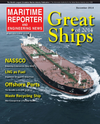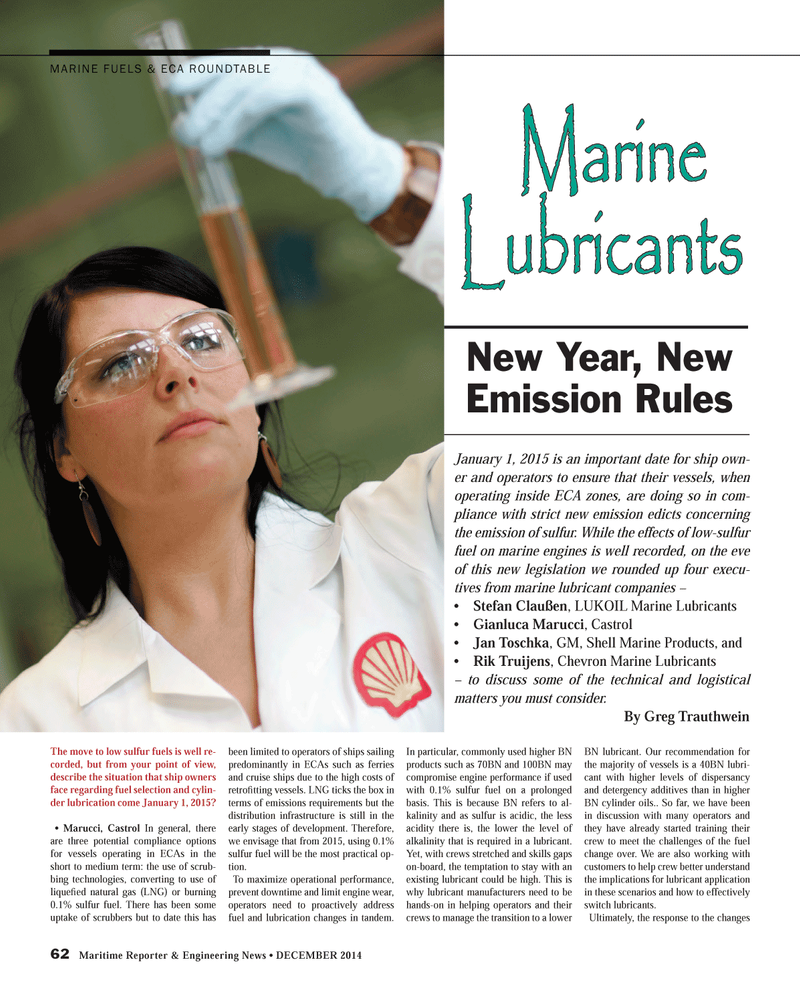
Page 62: of Maritime Reporter Magazine (December 2014)
Great Ships of 2014
Read this page in Pdf, Flash or Html5 edition of December 2014 Maritime Reporter Magazine
62 Maritime Reporter & Engineering News • DECEMBER 2014
MARINE FUELS & ECA ROUNDTABLE
The move to low sulfur fuels is well re- corded, but from your point of view, describe the situation that ship owners face regarding fuel selection and cylin- der lubrication come January 1, 2015? • Marucci, Castrol In general, there are three potential compliance options for vessels operating in ECAs in the short to medium term: the use of scrub- bing technologies, converting to use of liquefi ed natural gas (LNG) or burning 0.1% sulfur fuel. There has been some uptake of scrubbers but to date this has been limited to operators of ships sailing predominantly in ECAs such as ferries and cruise ships due to the high costs of retrofi tting vessels. LNG ticks the box in terms of emissions requirements but the distribution infrastructure is still in the early stages of development. Therefore, we envisage that from 2015, using 0.1% sulfur fuel will be the most practical op- tion.
To maximize operational performance, prevent downtime and limit engine wear, operators need to proactively address fuel and lubrication changes in tandem.
In particular, commonly used higher BN products such as 70BN and 100BN may compromise engine performance if used with 0.1% sulfur fuel on a prolonged basis. This is because BN refers to al- kalinity and as sulfur is acidic, the less acidity there is, the lower the level of alkalinity that is required in a lubricant.
Yet, with crews stretched and skills gaps on-board, the temptation to stay with an existing lubricant could be high. This is why lubricant manufacturers need to be hands-on in helping operators and their crews to manage the transition to a lower
BN lubricant. Our recommendation for the majority of vessels is a 40BN lubri- cant with higher levels of dispersancy and detergency additives than in higher
BN cylinder oils.. So far, we have been in discussion with many operators and they have already started training their crew to meet the challenges of the fuel change over. We are also working with customers to help crew better understand the implications for lubricant application in these scenarios and how to effectively switch lubricants.
Ultimately, the response to the changes Marine
Lubricants
New Year, New
Emission Rules
January 1, 2015 is an important date for ship own- er and operators to ensure that their vessels, when operating inside ECA zones, are doing so in com- pliance with strict new emission edicts concerning the emission of sulfur. While the effects of low-sulfur fuel on marine engines is well recorded, on the eve of this new legislation we rounded up four execu- tives from marine lubricant companies – • Stefan Claußen, LUKOIL Marine Lubricants • Gianluca Marucci, Castrol • Jan Toschka, GM, Shell Marine Products, and • Rik Truijens, Chevron Marine Lubricants – to discuss some of the technical and logistical matters you must consider.
By Greg Trauthwein
MR #12 (58-65).indd 62 12/2/2014 2:41:04 PM

 61
61

 63
63
